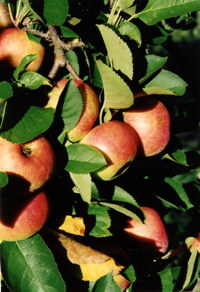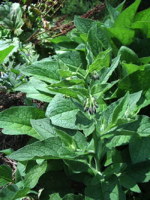Functional Orchard Update summer 2014
“The whole is greater than the sum of its parts.”

The five-year-old one-acre “functional orchard” in our backyard is looking more like a jungle each year. That’s intentional. The idea is to grow fruit trees in a mixed plant environment and see what happens. You might call it semi-organized chaos. Forty apple trees surround a small pond in three concentric ovals. The trees themselves are surrounded by dozens of plant species. We introduced many of these woody and herbaceous “companions” while others have popped up spontaneously.
At first I was tempted to remove all the volunteers. After all, this is agriculture and I should be in control, right? But I’ve resisted the temptation to “weed out the weeds.” I like to think of agriculture as a partnership between plants and people. I want to have a hand in what’s going on in the functional orchard, but not a heavy hand. I want to trust the plants themselves. If they want to be there, maybe there’s good reason.
It’s not entirely laissez-faire however. I do use what I hope is a light touch. I keep each apple tree cleared about 12" around the base. I also remove volunteer trees. This is suppose to be an orchard, not the woods. I minimize external inputs: any plants I snip off or pull out get laid right there on the ground. The orchard floor becomes the compost heap, as it is in nature.

I get out into the functional orchard as often as I can. Regular observation is an essential part of learning this stuff. You can’t overdo it. Here are a few of this year’s observations:
- The apple trees seem to like the current set-up. They are thriving among all the companions. They have made good use of this summer’s rain. The shoot growth has been great. Foliage color is a nice rich green.
- The soil is improving. We started with a woodsy duff and ledge. The hugel mounds are decomposing. The soil is moist, and the color is darkening.
- The companions like it here, too. The site is now covered with plants ranging in height from low ground covers to 3–4' tall. Most of the growing season the orchard has been a riot of color. We are maximizing the number of flowers and the amount of aromatics. I’d like to think we’re confusing the heck out of the pests.
- There has been no borer damage at all. While the young trees in our more traditional orchard up the road have been hit by borers, something about this orchard seems to be fooling them. Could diversity be the best protection?
- Drawbacks? The voles also like the new arrangement. Voles love dark protected environments with lots of plant cover. The cats and the goshawk have been hard at work but still we have a great crop of voles out there. A couple of the functional orchard trees have seen a small amount of summer vole damage. This is unusual. Another reason to keep the plants weeded back from the trunk 12" or so.
How do you prove this system works? Maybe that’s impossible. The scientific method isolates and tests. But this is not about the efficacy of one plant or another. Rather, it’s about creating a community of interconnected plants where each one plays a role in a complicated system. The whole is greater than the sum of its parts.
So we continue to plant and observe in the functional orchard and hope that it functions. Stay tuned.
John Bunker
